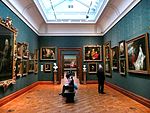UNITED KINGDOM, 15th November 2010 – The Wikimedia Foundation, the non-profit organisation behind Wikipedia, today launches its seventh annual fundraising appeal. The 2010 campaign seeks to raise the funds needed to maintain and grow Wikipedia, the world’s fifth-most-popular site, as a space for the free and open sharing of human knowledge. This year the Foundation’s goal is $16 million.
As part of the appeal, Wikimedia UK, the local affiliate of the Wikimedia Foundation covering the United Kingdom, is hoping to raise £500,000 by January 2011. Donations to Wikimedia UK will continue to fund the people and technology behind Wikipedia as well as support existing community driven training programmes and start new initiatives.
These training programmes will continue to encourage and educate academia, the cultural sector and corporate entities in how to contribute and use Wikipedia and its sister sites. They teach companies and employees how to work with Wikipedia to share their knowledge with the world, and how to add their material to (and reuse material from) Wikipedia and other fast growing Wikimedia projects such as Wikimedia Commons, an online repository of images, sound and other media files.
Andrew Turvey, Chair of Wikimedia UK, says: “There is a phenomenal amount of content available through Wikimedia projects – there are 9,430 new Wikipedia articles in 270 languages added daily to the 16 million already in existence, and over 7.3 million freely licensed images available via Wikimedia Commons for anyone to use. The funding will allow us to build on this success and broaden out content available by showing UK academics, cultural organisations and public and private sector employees how Internet users and organisations can benefit, if they learn to use Wikimedia projects, especially Wikipedia, in the right way.”
Wikimedia UK has already made great strides within the culture sector with Wikimedia volunteers working with the British Museum to share knowledge of its collections online. Wikimedia partnered with the British Museum to host a GLAM-WIKI conference. The conference is on 26th/27th November 2011 and will showcase how some Museums are already reaping benefits from sharing their collections with Wikimedia. Advantages to organisations that have previously shared content have included a sharp increase in web traffic to the Museums’ websites and an increase in sales of merchandising.
“Our training programmes and technological improvements are key priorities for Wikimedia UK in 2011”, adds Turvey.
To make a donation, please click on the banners on the Wikipedia site.
Follow us on:
Follow or share your thoughts on Twitter with the hashtag #keepitfree
-Ends-
About Wikimedia UK
Wikimedia UK (incorporated under the name “Wiki UK Limited“) is the local Wikimedia chapter covering the United Kingdom.
Wikimedia UK is a separate organisation from the Wikimedia Foundation, and has no control over the contents of Wikipedia or any other projects run by the Wikimedia Foundation. It exists to help collect, develop and distribute freely licensed knowledge (and other educational, cultural and historic content), which we do by supporting the charitable activities of the Wikimedia Foundation.
For further information about Wikipedia UK, please visit:
About The Wikimedia Foundation
The Wikimedia Foundation is the non-profit organization which operates Wikipedia, the free encyclopedia. According to comScore Media Metrix, Wikipedia and the other projects operated by the Wikimedia Foundation receive 398 million unique visitors per month, making them the 5th most popular web property world-wide (Sept, 2010). Available in more than 270 languages, Wikipedia contains more than 16 million articles contributed by a global volunteer community of more than 100,000 people. Based in San Francisco, California, the Wikimedia Foundation is an audited, 501(c)(3) charity that is funded primarily through donations and grants.
For further information, please contact:
Gemma Griffiths
Tel: +44 (0)7545 768 602
Email: gemma.griffiths@wikimedia.org.uk
Michael Peel, Secretary, Wikimedia UK
Tel: +44 (0)7988 013 646
Email: michael.peel@wikimedia.org.uk
















 Wikimedia UK is growing. Since we were founded nearly two years ago we have raised nearly £100,000 to support Wikipedia and similar open content work; we have hosted an international conference and arranged a museum backstage pass event and run an event with twenty museums across the country generating free images for Wikipedia; over 80 people have become members; and we have made significant progress towards getting charity status.
Wikimedia UK is growing. Since we were founded nearly two years ago we have raised nearly £100,000 to support Wikipedia and similar open content work; we have hosted an international conference and arranged a museum backstage pass event and run an event with twenty museums across the country generating free images for Wikipedia; over 80 people have become members; and we have made significant progress towards getting charity status.